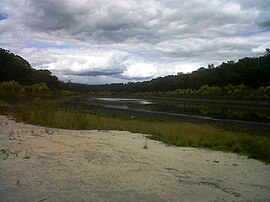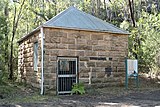Protected area in New South Wales, Australia
| Thirlmere Lakes National Park New South Wales | |
|---|---|
| IUCN category II (national park) | |
 Thirlmere Lakes Thirlmere Lakes | |
 | |
| Nearest town or city | Couridjah |
| Coordinates | 34°13′32″S 150°32′19″E / 34.22556°S 150.53861°E / -34.22556; 150.53861 |
| Established | 7 April 1972 (1972-04-07) |
| Area | 6.29 km (2.4 sq mi) |
| Managing authorities | NSW National Parks and Wildlife Service |
| Website | Thirlmere Lakes National Park |
| See also | Protected areas of New South Wales |
The Thirlmere Lakes National Park is a protected national park that is located in the Macarthur region of New South Wales, in eastern Australia. The 629-hectare (1,550-acre) national park is situated approximately 70 kilometres (43 mi) southwest of the Sydney central business district, and just to the west of Thirlmere. It was gazetted in 1972 as Thirlmere Lakes State Park, before being subsequently reclassified as a national park.
History
The national park is one of the eight protected areas that, in 2000, was inscribed to form part of the UNESCO World Heritage–listed Greater Blue Mountains Area. The Thirlmere Lakes National Park is the most south–easterly and the smallest of the eight protected areas within the World Heritage Site.
Crisis
Two of the lakes have dried out since the mid 1980s due to removal of groundwater in the region secondary to coal mining at the Tahmoor Colliery. The local community is investigating plans to revive the lakes, which might take decades otherwise.
Features
The main feature of the park are the lakes, thought to have formed around 15 million years ago by geological activity, the land lifting and largely cutting them off from the local river system. Their outflow is reduced to the small Blue Gum Creek, which flows west into the Little River in the adjacent Nattai National Park to the west.
The lakes and their environs contain an unusual and diverse array of flora and fauna. It contains the rare freshwater sponge Radiospongilla sceptroides, and is notable for an absence of freshwater snails. The lakes contain the rare watershield (Brasenia schreberi) and are lined with rare species such as the grey sedge (Lepironia articulata) and the wooly frogsmouth lily (Philydrum lanuginosum). The habitat provides a home for the otherwise scarce Australasian bittern (Botaurus poiciloptilus), and migratory Latham's snipe Gallinago hardwickii.
The habitat around the lakes is open sclerophyll forest, the dominant trees being rough-barked apple (Angophora floribunda) nearby and sydney peppermint (Eucalyptus piperita) and red bloodwood (Corymbia gummifera) on elevated areas. The understory species include many familiar sydney sandstone flora such as members of the genera Banksia, Acacia, pea flowers, and the New South Wales waratah (Telopea speciosissima)
Climate
| Thirlmere Lakes National Park | ||||||||||||||||||||||||||||||||||||||||||||||||||||||||||||
|---|---|---|---|---|---|---|---|---|---|---|---|---|---|---|---|---|---|---|---|---|---|---|---|---|---|---|---|---|---|---|---|---|---|---|---|---|---|---|---|---|---|---|---|---|---|---|---|---|---|---|---|---|---|---|---|---|---|---|---|---|
| Climate chart (explanation) | ||||||||||||||||||||||||||||||||||||||||||||||||||||||||||||
| ||||||||||||||||||||||||||||||||||||||||||||||||||||||||||||
| ||||||||||||||||||||||||||||||||||||||||||||||||||||||||||||
Gallery
Photos of Thirlmere Lakes National Park-
 Thirlmere Lake in Thirlmere Lakes National Park
Thirlmere Lake in Thirlmere Lakes National Park
-
 Pumphouse supplying water for steam trains at Couridjah Station
Pumphouse supplying water for steam trains at Couridjah Station
-
 The five lakes in Thirlmere Lakes National Park
The five lakes in Thirlmere Lakes National Park
-
 Ford in Thirlmere Lakes National Park
Ford in Thirlmere Lakes National Park
See also
References
- ^ "Thirlmere Lakes National Park: Park management". Office of Environment and Heritage. Government of New South Wales. Retrieved 26 May 2011.
- ^ Wright, Peter (1996). National Parks of Southern NSW. Rosebery, NSW: Bridge Printery. pp. 36–37. ISBN 0-9587590-1-4.
- "Greater Blue Mountains Area". World Heritage List. UNESCO. 2014. Retrieved 31 August 2014.
- Miskelly, Greg (29 May 2016). "Thirlmere Lakes: Coal mining to blame for damage to World Heritage area, new reports say". ABC News. Retrieved 29 August 2016.
- Miskelly, Greg (30 May 2016). "Thirlmere Lakes: CLocals push for action to stop World Heritage area drying out". ABC News. Retrieved 29 August 2016.
- ^ "Thirlmere Lakes National Park: New Plan of Management" (PDF). NSW National Parks and Wildlife Service (PDF). Government of New South Wales. November 1997. ISBN 0-7310-7619-2.
- "NASA Earth Observations: Population Density". "NASA/SEDAC". Retrieved 30 January 2016.
External links
- "Thirlmere Lakes National Park" (PDF) (PDF Map). NSW National Parks and Wildlife Service. Government of New South Wales. December 2007.
 Thirlmere Lakes National Park travel guide from Wikivoyage
Thirlmere Lakes National Park travel guide from Wikivoyage
| Blue Mountains topics | |
|---|---|
| Towns, suburbs and localities |
|
| Mountain peaks | |
| Tourist attractions | |
| Valleys | |
| Waterfalls | |
| History |
|
| National parks | |
| Rivers | |
| Schools | |
| Miscellaneous | |
| Disasters | |
| List of subjects | |